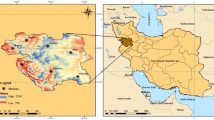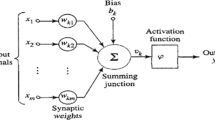Abstract
In this work, artificial neural networks (ANNs) were developed and applied in order to forecast the discomfort levels due to the combination of high temperature and air humidity, during the hot season of the year, in eight different regions within the Greater Athens area (GAA), Greece. For the selection of the best type and architecture of ANNs-forecasting models, the multiple criteria analysis (MCA) technique was applied. Three different types of ANNs were developed and tested with the MCA method. Concretely, the multilayer perceptron, the generalized feed forward networks (GFFN), and the time-lag recurrent networks were developed and tested. Results showed that the best ANNs type performance was achieved by using the GFFN model for the prediction of discomfort levels due to high temperature and air humidity within GAA. For the evaluation of the constructed ANNs, appropriate statistical indices were used. The analysis proved that the forecasting ability of the developed ANNs models is very satisfactory at a significant statistical level of p < 0.01.





Similar content being viewed by others
References
Antonic O, Hatic D, Krian J, Bukocev D (2001) Modelling groundwater regime acceptable for the forest survival after the building of the hydro-electric power plant. Ecol Model 138:277–288
Atthajariyakul S, Leephakpreeda T (2005) Neural computing thermal comfort index for HVAC systems. Energ Convers Manage 46:2553–2565
Becker S, Potchter O, Yaakov Y (2003) Calculated and observed human thermal sensation in an extremely hot and dry climate. Energ Buildings 35:747–756
Besancenot JP (1978) Le bioclimat humain de Rio. In: Suchel JB, Altes E, Besancenot JP, Maheras P (eds) Recherches de Climatologie en Milieu Tropical et Mediterranean. Cahier No. 6 du Centre de Recherches de Climatologie. Universite de Dijon, Dijon
Bishop C (1995) Neural networks for pattern recognition. Oxford University Press, Oxford
Ceravolo F, De Felice M, Pizzuti S (2009) Combining back-propagation and genetic algorithms to train neural networks for ambient temperature modelling in Italy. Appl EvolComput 5484:123–131. doi:10.1007/978-3-642-01129-0_16
Chronopoulos KI, Tsiros IX, Dimopoulos IF, Alvertos N (2008) An application of artificial neural network models to estimate air temperature data in areas with sparse network of meteorological stations. J Environ Sci Health A Tox Hazard Subst Environ Eng 43:1752–1757
Chronopoulos KI, Tsiros IX, Alvertos N (2011) Assessment of bioclimatic comfort using artificial neural network models—a preliminary study in a remote mountainous area of southern Greece. Acta Climatologica et Chorologica 44–45:65–71
Cohen P, Oded Potchter O, Matzarakis A (2012) Daily and seasonal climatic conditions of green urban open spaces in the Mediterranean climate and their impact on human comfort. Build Environ 51:285–295
Comrie AC (1997) Comparing neural networks and regression models for ozone forecasting. J Air Waste Manage 47:653–663
Conti S, Meli P, Menelli G, Solimini R, Toccaceli V, Vichi M, Beltrano C, Perini L (2005) Epidemiologic study of mortality during the summer 2003 heat wave in Italy. Environ Res 98:390–399
Díaz J, Garcia R, de Velazquez CF, Hernandez E, Lopez C, Otero A (2002) Effects of extremely hot days on people older than 65 years in Seville (Spain) from 1986 to 1997. Int J Biometeorol 46(3):145–149
Dreyfus G (2005) Neural networks: methodology and applications. Springer, Berlin
Elbir T (2003) Comparison of model predictions with the data of an urban air quality monitoring network in Izmir, Turkey. Atmos Environ 37:2149–2157
Fiala D, Havenith G, Bröde P, Kampmann B, Jendritzky G (2011) UTCI-Fiala multi-node model of human heat transfer and temperature regulation. Int J Biometeorol. doi:10.1007/s00484-011-0424-7
Giles BD, Balafoutis CH, Maheras P (1990) Too hot for comfort: the heatwaves in Greece in 1987 and 1988. Int J Biometeorol 34:98–104
Gobakis K, Kolokotsab D, Synnefac A, Saliari M, Giannopoulou K, Santamouris M (2011) Development of a model for urban heat island prediction using neural network techniques. Sustain Cities Soc 1:104–115
Hajat S, Kosatky T (2010) Heat-related mortality: a review and exploration of heterogeneity. J Epidemiol Community Health 64:753–760
Höppe PR (1999) The physiological equivalent temperature—a universal index for the biometeorological assessment of the thermal environment. Int J Biometeorol 43:71–75
Jendritzky G, Maarouf A, Fiala D, Staiger H (2002) An update on the development of a universal thermal climate index. 15th Conf. Biomet. Aerobiol. And 16th ICB02, 27 Oct–1 Nov 2002, Kansas City, AMS: 129–133
Jiang Y (2008) Prediction of monthly mean daily diffuse solar radiation using artificial neural networks and comparison with other empirical models. Energ Policy 36:3833–3837
Karul C, Soyupak S, Cilesiz AF, Akbay N, Germen E (2000) Case studies on the use of neural networks in eutrophication modeling. Ecol Model 134:145–152
Kostopoulou E, Giannakopoulos C, Anagnostopoulou C, Tolika K, Maheras P, Vafiadis M, Founda D (2007) Simulating maximum and minimum temperature over Greece: a comparison of three downscaling techniques. Theor Appl Climatol 90:65–82
Ma CCY, Iqbal M (1983) Statistical comparison of models for estimating solar radiation on inclined surgaces. Sol Energy 31:313–317
Matzarakis A, Mayer H (1991) The extreme heat wave in Athens in July 1987 from the point of view of human biometeorology. Atmos Environ 25(2):203–211
Matzarakis A, Nastos PT (2010) Human-biometeorological assessment of heat waves in Athens. Theor Appl Climatol 105(1):99–106
Matzarakis A, Mayer H, Iziomon M (1999) Applications of a universal thermal index: physiological equivalent temperature. Int J Biometeorol 43:76–84
Mayer H, Höppe P (1987) Thermal comfort of man in different urban environments. Theor Appl Climatol 38:3–49
McGregor GR, Markou MT, Bartzokas A, Katsoulis BD (2002) An evaluation of the nature and timing of summer human thermal discomfort in Athens, Greece. Clim Res 20:83–94
Mendoza GA, Macou P, Prahbu R, Sukadri D, Purnomo H and Hartanto H (1999) Guidelines for applying multi-criteria analysis to the assessment of criteria and indicators. Criteria & Indicators Toolbox series No. 9. Jakarta, Indonesia: CIFOR. Available at: http://www.cifor.cgiar.org/acm/methods/toolbox9.html
METEONET (2011) Hydrological Observatory of Athens. Available at: http://hoa.ntua.gr/info
Mihalakakou G, Flocas HA, Santamouris M, Helmis CG (2002) Application of neural networks to the simulation of the heat island over Athens, Greece, using synoptic types as a predictor. J Appl Meteorol 41(5):519–527
Moon JW, Kim JJ (2010) ANN-based thermal control models for residential buildings. Build Environ 45:1612–1625
Moon JW, Jung SK, Kim JJ (2009) Application of ANN (artificial-neural-network) in residential thermal control. In: Eleventh International IBPSA Conference. Building Simulation 2009. Glasgow, Scotland, 27–30 July, 2009. pp. 64–71
Moustris KP, Ziomas IC, Paliatsos AG (2009) 24 Hours in advance forecasting of thermal comfort–discomfort levels during the hot period of the year at representative locations of Athens city, Greece. Fresen Environ Bull 18(5):601–608
Moustris KP, Tsiros IX, Ziomas IC, Paliatsos AG (2010a) Artificial neural network models as a useful tool to forecast human thermal comfort using microclimatic and bioclimatic data in the great Athens area (Greece). J Environ Sci Heal A 45:447–453
Moustris KP, Ziomas IC, Paliatsos AG (2010b) 3-Day-ahead forecasting of regional pollution index for the pollutants NO2, CO, SO2, and O3 using artificial neural networks in Athens, Greece. Water Air Soil Poll 209:29–43
Muthers S, Matzarakis A, Koch E (2010) Summer climate and mortality in Vienna—a human biometeorological approach of heat-related mortality during the heat waves in 2003. Wien Klin Wochenschr 122:525–531
Nastos PT, Matzarakis Α (2006) Weather impacts on respiratory infections in Athens, Greece. Int J Biometeorol 50:358–369
Nastos PT, Matzarakis A (2008a) Human-biometeorological effects on sleep disturbances in Athens, Greece: a preliminary evaluation. Indoor Built Environ 17(6):535–542
Nastos PT, Matzarakis Α (2008b) Variability of tropical days over Greece within the second half of the twentieth century. Theor Appl Climatol 93:75–89
Nastos PT, Matzarakis A (2011) The effect of air temperature and human thermal indices on mortality in Athens, Greece. Theor Appl Climatol. doi:10.1007/s00704-011-0555-0
Nunnari G, Dorling S, Schlink U, Cawley C, Foxall R, Chatterton T (2004) Modelling SO2 concentration at a point with statistical approaches. Environ Modell Softw 19:887–905
Paliatsos AG, Nastos PT (1999) Relation between air pollution episodes and discomfort index in the greater Athens area, Greece. Global Nest J 1:91–97
Papanastasiou D, Melas D, Kioutsioukis I (2007) Development and assessment of neural network and multiple regression models in order to predict PM10 levels in a medium-sized Mediterranean city. Water Air Soil Poll 182:325–334
Pelliccioni A, Cotroneo R, Pungi F (2010) Optimization of neural net training using patterns selected by cluster analysis: a case-study of ozone prediction level. Eighth conference on Artificial Intelligence and its Applications to the Environmental Sciences, AMS 90th Annual Meeting, Atlanta, Georgia, 17–21 January, 2010. Available at: http://ams.confex.com/ams/90annual/techprogram/session_23974.htm
Philandras CM, Metaxas DA, Nastos PT, Repapis CC (1999) Climate variability and urbanization in Athens. Theor Appl Climatol 63:65–72
Santamouris M, Mihalakakou G, Papanikolaou N, Asimakopoulos DN (1999) A neural network approach for modeling the heat island phenomenon in urban areas during the summer period. Geophys Res Lett 26(3):337–340
Shahi A, Atan RB, Sulaiman MN (2009) Detecting effectiveness of outliers and noisy data on fuzzy system using FCM. Eur J Sci Res 36:627–638
Shimizu Y, Jindo T (1995) A fuzzy logic analysis method for evaluating human sensitivities. Int J Ind Ergonom 15:39–47
Siple PA, Passel CF (1945) Measurements of dry atmospheric cooling in subfreezing temperatures. Proc Am Philos Soc 89:177–199
Spagnolo J, de Dear R (2003) A field study of thermal comfort in outdoor and semi-outdoor environments in subtropical Sydney Australia. Build Environ 38:721–738
Theoharatos G, Pantavou K, Mavrakis A, Spanou A, Katavoutas G, Efstathiou P, Mpekas P, Asimakopoulos D (2010) Heat waves observed in 2007 in Athens, Greece: Synoptic conditions, bioclimatological assessment, air quality levels and health effects, Greece. Environ Res 110:152–161
Thom EC (1959) The discomfort index. Weatherwise 12:57–60
Tseliou A, Tsiros IX, Lykoudis S, Nikolopoulou M (2010) An evaluation of three biometeorological indices for human thermal comfort in urban outdoor areas under real climatic conditions. Build Environ 45:1346–1352
Tzenkova AS, Kandjov IM, Ivancheva JN (2003) Some biometeorological aspects of urban climate in Sofia. Proc of Fifth Int Conf Urban Climate, Lodz, Poland 2:103–106
Velten K (2009) Mathematical modeling and simulation: introduction for scientists and engineers. Wiley, Germany
Yang IH, Kim KW (2004) Prediction of the time of room air temperature descending for heating systems in buildings. Build Environ 39:19–29
Acknowledgments
This work was done with the assistance of the Postgraduate Program “MSc in Energy” which co-organized by the Department of Mechanical Engineering, TEI of Piraeus, Greece and the School of Engineering and Physical Sciences, Heriot-Watt University, UK.
Author information
Authors and Affiliations
Corresponding author
Rights and permissions
About this article
Cite this article
Vouterakos, P.A., Moustris, K.P., Bartzokas, A. et al. Forecasting the discomfort levels within the greater Athens area, Greece using artificial neural networks and multiple criteria analysis. Theor Appl Climatol 110, 329–343 (2012). https://doi.org/10.1007/s00704-012-0626-x
Received:
Accepted:
Published:
Issue Date:
DOI: https://doi.org/10.1007/s00704-012-0626-x




